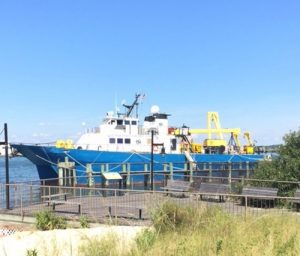
OCEAN CITY — The future development of a vast wind energy farm off the resort’s coast took another step toward becoming a reality last week when the lease-holder began a marine survey of the 80,000-acre site offshore in advance for the final project design.
In August 2014, the federal Bureau of Ocean Energy Management (BOEM) issued an $8.7 million lease to U.S. Wind, Inc., a Texas-based company with ties to a successful offshore wind developer in Italy, for the Maryland Wind Energy Area (WEA), which includes two adjacent lease areas totaling 80,000 acres off the coast of Ocean City for the development of a future offshore wind energy farm. The Maryland WEA covers roughly 94 square nautical miles with its western edge roughly 10 miles off the coast of Ocean City with its eastern edge extending about 30 miles out.
Since the lease, U.S. Wind has been going through the requisite regulatory hurdles, including approval from the Maryland Public Service Commission along with other bureaucratic red tape, but the company now appears to be poised to begin the massive project, which would be the first of its kind along the east coast. Similar leases have been approved for other offshore wind energy farms off the coasts of mid-Atlantic states, but those projects are further behind in the regulatory process.
Last week, U.S. Wind began a marine survey in preparation for the final layout design for the 80,000-acre wind energy project off Ocean City’s coast. U.S. Wind has contracted with Alpine Ocean Seismic Survey and its vessel R/V Shearwater to begin conducting data collection along the 35-mile route from the project site off the coast of Ocean City to its landfall destination.
The energy generated by the wind farm off the resort’s coast will have to come ashore at some point to connect to the vast electric service grid and the current plan is to bring the line ashore at some point near the Indian River Inlet to connect to a power plant in Millsboro. As a result, the Shearwater will be taking sediment core samples at 36 locations along the route to test the composition of the sea floor and ensure it is safe for the power cable. The survey is expected to take about two weeks.
“This is a significant milestone in our effort to bring offshore wind and its many benefits to Maryland,” said U.S. Wind Director of Project Development Paul Rich this week. “Over the coming months, we will be undertaking more activities to ensure the success of the project and position Maryland as the east coast hub for the booming offshore wind industry.”
According to U.S. Wind, Maryland is poised to develop the nation’s first large-scale offshore wind farm. The estimated 750-megawatt project includes the construction of 187 wind turbines in the WEA off the resort’s coast, which would produce power for more than 500,000 homes. In addition to the current marine survey, other upcoming activities include constructing and installing a meteorological station to assess weather conditions at the site.
U.S. Wind forecasts the project will create thousands of jobs during the construction process along with hundreds of well-paying, long-term careers once the offshore wind farm is up and running.
“As this first-mover for the new American industry, Maryland will become the epicenter of the industry, providing us a new, robust industry for a generation,” said Rich. “This will bring much-needed jobs to Eastern Shore areas that really need them.”
U.S. Wind experts have said the proposed wind project off the Ocean City coast will also help alleviate a long-standing power deficiency on the Eastern Shore. Because Maryland already imports much of its electricity, the Maryland Energy Administration (MEA) estimates Marylanders pay roughly $250 million per year in congestion fees bundles in their monthly utility bills. The wind energy farm off the coast of of the resort is expected to ease those congestion costs.
“Injecting 750 megawatts of new power into the Eastern Shore grid will significantly help alleviate the electricity imbalance and reduce or eliminate much of this hidden tax,” said Rich. “Maryland ratepayers are projected to see a net decrease of $2 or more in their monthly bills as a result of U.S. Wind’s project.”

